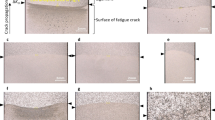Abstract
The present work provides a semi-empirical model to show that the growth rate of thermal displacement-induced cracks in semiconductor devices depends on pattern thickness. Paris’s law is adopted to characterize the growth rate of cracks during thermal-cycling. The crack propagation rate is estimated from the semi-empirical relation (dc/dN)v=C(ΔK)n, where ΔK indicates the range of an applied stress intensity factor, and C is a scaling constant. The applied stress intensity factor is related to the initial crack length as ΔK=YΔσ(πc)1/2, where σ represents the thermal displacement-induced normal stress, c describes the pre-existing crack length, and Y is a geometrical factor. The resulting crack growth rate can be expressed as a function of device pattern thickness: dc/dN∞(1/t)m, where t describes the pattern thickness, and m is another constant. The present semi-empirical results showing the relationship between the crack growth rate and pattern thickness indicate that if a semiconductor device pattern becomes thinner by 68%, its susceptibility to thermal cycling-induced damage will be enhanced by 76%.
Similar content being viewed by others
References
E. Suhir,Proc. 37 th Elec. Comp. Conf., p. 598, IEEE/(EIA) (1987).
S. W. Groothuis and M. Murtuza,Proc. 23 rd Annual Int. Rel. Symp., p. 184, IEEE (1985).
D. Edwards, K. G. Heinen, S. K. Martines, and J. E. Martines,IEEE Trans. Comp., Hybrids, and Manu. Tech., CHMT-12(4), p. 427–434, IEEE (1987).
G. S. Ganesan, G, Lewis, A. Woosley, W. Lindsay, and H. Berg,Proc. of the ECTC, p. 450–454, IEEE (1995).
M. Lamson, D. Edwards, S. Groothuis, G. Heinen,Proc. of the IEEE ECTC, p. 1045–1050, IEEE (1993).
S. M. Lee, J.-H. Lee, S.-Y. Oh, and H.-K. Chung,Proc. of the IEEE ECTC, p. 455–462, IEEE (1995).
S. M. Lee and K. W. Lee,Jpn. J. Appl. Phys. 35, 5465 (1996).
S. M. Lee,J. Mater. Res. 13, 1967 (1998).
S. M. Lee,Jpn. J. Appl. Phys. 41, 3860 (2002).
A. S. Tetalman and A. J. McEvily,Fracture of Structural Materials, p. 347–350, Iohn Wiley & Sons (1967).
Author information
Authors and Affiliations
Corresponding author
Rights and permissions
About this article
Cite this article
Lee, SM. Application of Paris’s law to thermal cycling-induced failure in semiconductor device patterns. Met. Mater. Int. 14, 799–802 (2008). https://doi.org/10.3365/met.mat.2008.12.799
Issue Date:
DOI: https://doi.org/10.3365/met.mat.2008.12.799




